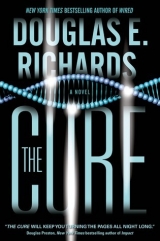
Текст книги "The Cure"
Автор книги: Douglas E. Richards
Жанры:
Триллеры
,сообщить о нарушении
Текущая страница: 4 (всего у книги 22 страниц)
Dean Borland shook his head. “Consider yourself lucky that I let you go on this long,” he added. “You were a hair away from being removed from the project a year ago. I don’t know if you’re bad luck or what. But as good and dedicated a student as you are, trouble follows you. There are a number of groups around the world visiting prisons and studying psychopaths. So how is it that all of them combined have had one test subject die during their studies, and you’ve had three? In the past two years. This project was damned from the beginning.”
Erin was speechless, but Apgar didn’t have this same problem. This decision impacted him as much as it did his student. As her advisor, Apgar would be a coauthor on the scholarly papers that would come from the research. “Richard, these unfortunate deaths are a separate issue,” he insisted. “Having nothing to do with the Wall Street Journal piece. So I hope you didn’t factor them in to reach your decision. Two prisoners had a stroke and died in their sleep. Yes, it was one in a million, but one-in-a-million events happen. Every day. The pathologist verified their strokes had nothing to do with Erin’s research activities.”
“Okay, two deaths are one in a million,” responded the dean. “But then add in her being attacked in the trailer. I don’t believe in curses, but if I did, this project would be cursed. Three inmate deaths. What are the odds of that?”
“Would you have preferred I let him kill me?” said Erin angrily. “Would that have helped the odds? Two inmates and a grad student dead?”
“No, of course not. Although you could have told us you were a female Chuck Norris earlier. Before this happened, Jason and I used to wonder if we were insane for agreeing to let you do this project in the first place. If we would have known how easy it was for the hundred-and-twenty-pound damsel to strike a lethal blow against the two-hundred-pound, weight-lifting inmate, we could have saved ourselves the trouble.”
“I didn’t mean to crush his windpipe,” said Erin. “It was self-defense, and I struck harder than I realized. But why rehash any of this? I can only second what Dr. Apgar has said. The prison conducted a thorough investigation of all three deaths, and I was exonerated. If I hadn’t been, the prison wouldn’t have let me continue. So that’s in the past. It isn’t fair to link that case and this one.”
“Yes it is,” said Borland. “Because I’ve already been asked about these deaths today by the media. The media and the ACLU don’t have to do much digging into your research to learn about these incidents. It’s not like they’re hidden. They just pop right out. I have no doubt some people will wonder if you’re studying inmates, or picking them off one by one, Ten Little Indians style.”
Erin frowned deeply. “The thing about the wireless psychopath detector was a mistake. I admit that. But one I made years ago and didn’t repeat. The other incidents happened, but I had nothing to do with them. Please don’t do this,” pleaded Erin. “Not now. Just give me a single week.”
The dean shook his head, his expression even grimmer than before, if this was even possible. “I’m sorry,” he said in a tone that suggested he really wasn’t. “But you’re done. As of this second. And no power on earth is going to change that.”
5
“GOOD MORNING, ERIN,” said Alejandro cheerfully as she entered the prison grounds and the heavy steel door slid shut loudly behind her.
“Morning,” she said, adjusting her hideous and useless glasses and trying hard not to look as nervous as she felt.
She had ended her meeting with Dean Borland by making sure he knew how much she disagreed with his decision, but also making it clear that she was prepared to respect it. She would halt her current study and begin writing her doctoral thesis. He was right. This was long overdue, and she had enough data for two doctorates.
She had assured both the dean and her advisor that she would inform prison authorities immediately that her study had come to an end, and make arrangements for the mobile lab to be removed from the yard once and for all. She had also told them she would be taking a two-week vacation to sort things out in her head and get a new lease on life, starting immediately. She would get a fellow grad student to fill in for the two missed teaching days this would entail.
After they had left the dean’s office, Apgar had apologized profusely for what had happened, and told her she was the most impressive graduate student he had ever had. She thanked him for trying to defend her and reassured him that her thesis would make him proud.
But she had no intention of pulling up stakes. Not when she was this close.
“I know you won’t believe this,” she said to Alejandro, “but I’m actually taking a vacation soon.” He had often told her she spent more time on the prison grounds than the inmates, and encouraged her to do just this.
“No!” said the guard in mock horror. “Say it isn’t so.”
Erin forced herself to smile. Her actions needed to appear perfectly normal, no matter how nervous she was on the inside. “I’m afraid it’s true. I finally decided to take your advice, Alejandro.”
She sighed. “But here’s the bad news. I have a lot I want to accomplish before I go. So I’ll be working far more hours than normal for at least the next few days. And seeing far more prisoners.”
“Is that even possible?”
“You wouldn’t think so,” she admitted. “But I’m planning to be very efficient. The inmates will be in and out. Like an assembly line. Each examination will be much shorter and more focused than usual.”
Her research would be quick and dirty. But she would have her confirmation. She hadn’t run a marathon to be stopped just a few blocks short of the finish line. Too much was at stake to let an academic bureaucrat stand in the way—even if he was right—which she knew in her heart he probably was. So she would forge ahead at top speed, not even stopping for the weekend, which luckily wasn’t a necessity, since a prison was the ultimate 24/7 establishment.
As Alejandro left to bring her the first prisoner on her lengthy list, she pulled out her cell phone and called her advisor, knowing he wouldn’t be in for another hour yet. She took a deep breath and tried to steady her nerves. The phone rang and then was kicked over to voice mail. She waited for his message and the beep, her heart beating faster than normal. This kind of deception wasn’t like her. But then again, she had been engaged in a vast deception for years—so maybe it was like her. She wasn’t sure who she was anymore.
She heard a loud beep and began. “Jason, this is Erin. I just wanted to let you know that I’ve notified the prison I won’t be coming back. And Mobile Medicine will pick up their MRI trailer later today, although, according to the lease, they’ll still bill us ’til the end of the month. If you need me for any reason while I’m away, feel free to call my cell. Anyway, give my best to everyone in the lab, and I’ll see you in a few weeks. And thanks again for giving me a chance to do this work—and for defending me.”
Erin ended the connection and stared off into space. If Apgar or the dean happened to call the prison this week, things could get very ugly, very quickly. And while they probably wouldn’t call, there were no guarantees. So she was working on borrowed time. At some point, something would happen to tip them off that she had lied to them and hadn’t yet pulled the plug. So she was in a race to the finish line. If she were caught, she was almost certain she could kiss her Ph.D. good-bye.
Alejandro returned with yet another in an endless series of men dressed in orange. The first of the morning. The first she would see in direct violation of the dean’s edict. This one was named Tony, and he had robed three convenience stores, wearing a Homer Simpson mask, killing the clerk in each store with a single bullet between the eyes.
Erin told Tony the visit would be shorter and more focused than usual.
“Too bad,” he responded with a friendly smile. “You know how much I enjoy your company.”
She nodded but didn’t reply. If only she hadn’t seen his record, or known him for what he was, she might have enjoyed his company as well.
Erin braced herself psychologically. It was going to be a long, long day. The first of many.
6
FIVE STRESS-FILLED DAYS and fifty-seven prisoners later, looking over her shoulder the entire time, expecting to be found out at any moment, Erin had her answer.
Her preliminary results had been confirmed. And then some.
She had purposely not breathed a word of her progress to Hugh Raborn in California. She hadn’t wanted to raise false hopes, only to later uncover sharp, exposed nails beneath what at first glance looked like a plush, inviting carpet. During her recent discussion with Raborn, she had been careful not to even hint that there was anything newsworthy to report. She hadn’t mentioned that she had been pulled from the project, or that she had been forging ahead against direct orders.
So should she call him now? Tell him the great news about their joint project?
She had finished her work by noon on Sunday and was all set to call him that night when she had an inspiration. This was the pinnacle of their work together. This news warranted more than just a video chat. It called for a celebration.
Everyone she knew was always encouraging her to open up, to be more spontaneous. So what better time to do it? Her entire lab thought she was on vacation, anyway, so why not take advantage of that and really get away for a few days?
And she had never even met Hugh Raborn. Sure, they had Skyped many times over the past few years, but for this, the ultimate achievement, she wanted to meet him in person. She had previously proposed coming out to San Diego to meet him, but the few times she had found a seam in her busy schedule, he was traveling. This was bad luck, certainly, but since he seemed to travel more than any ten people she knew, combined, it wasn’t entirely surprising—just disappointing. His travels usually led him to centers of biotechnology excellence like Boston, Washington, D.C., and the Bay Area. Unfortunately Tucson wasn’t on this list, and his duties as an executive and his travel schedule had so far precluded even a brief visit to the university to meet her.
If the truth were to be known, they had a great working relationship. And while she had made some feeble attempts to arrange a meeting, she suspected neither of them were sure this was a good idea. What if an actual, physical meeting somehow changed the dynamic between them? Why take any risk with such an effective relationship? If it wasn’t broken, why try to fix it?
But Erin knew her roommate was right. She did need human companionship. And a healthy dose of affection would do her psyche a world of good as well at this point. Hugh Raborn was older than she and wasn’t exactly a movie star, but she found him quite attractive. And he was single. Maybe she’d have her one-night stand. Maybe more than one night. They had become quite friendly, and although they mostly discussed the project, they had certainly connected on an intellectual basis. He would be thrilled by her unexpectedly quick breakthrough, and if she made her visit a surprise, delighted by this gesture.
Besides, one of her good friends, with whom she had become quite close when they were both winning medals at regional eighteen-and-under martial arts tournaments, lived in San Diego. So instead of holing up in her apartment until her fictitious vacation ended, she could get out. Go to the beach. See a friend. Clear her head. And maybe ignite the beginning of a romance.
Erin called her friend, Courtney, in San Diego. After catching up for fifteen minutes, Erin got to the point. “How do you feel about a visitor?” she said.
“You’re coming to San Diego?” said Courtney excitedly.
“I am. I’ve decided to be spontaneous for once.” She paused. “Which means that the visit is on short notice. Sorry about that.”
“Better short than never, I always say. And my apartment is your apartment. When are you coming?”
“I’m on the earliest flight in the morning.” The flight between Tucson and San Diego was little more than an hour. “I’ll be in by nine.”
Erin filled Courtney in on her plan to surprise Hugh Raborn, and possibly seduce him, without telling her about what they had been working on, or that she would be leaving the university sooner than she had expected. She would save that for when they were together. Maybe she would apply for a postdoc at the University of California, San Diego. Living in the most perfect climate on earth was tempting, and this way she could be close to both Raborn and Courtney.
“If Hugh Raborn is in,” said Erin, “and I’m not even going to check before I come—how’s that for spontaneous? Anyway, if he’s in, with any luck, I won’t need a place to sleep Monday night.”
“I’ve seen your effect on men, Erin. You won’t need luck. Well, as long as he’s not taken.”
“He’s not.”
“And he’s not gay?”
“No, he’s not gay.” Erin paused in thought. Raborn had mentioned he wasn’t in a current relationship, but he hadn’t spoken much about past ones either. “At least I don’t think he is,” she amended. “I guess there’s only one way to find out.”
“I have to admit, I’m intrigued by this new side of you.”
“Yeah, I’m full of surprises,” said Erin. “I should be the poster child for Girls Gone Wild,” she added wryly.
Erin waited for the laughter to subside on the other end of the phone. “How does this sound?” she continued. “We’ll definitely get together on Tuesday, whenever you can. And I’ll plan on spending the night at your apartment Tuesday night, if that’s all right with you.”
“Absolutely,” said Courtney. “And I think I can switch some things around at work and take the day off Tuesday, so we can hang out the entire day.”
“Fantastic,” said Erin happily.
“And if your … friend … isn’t in, or if things don’t work out, we can have dinner Monday night and you can stay at my place then as well.”
“I really appreciate it, Court. And sorry for putting top priority on this guy for Monday.”
“Are you kidding?” said Courtney. “I’m psyched for you. I can hardly wait to hear all about it when you wander in Tuesday morning,” she finished in amusement.
7
ERIN LEFT THE airport rental car lot in a white Ford subcompact. Soon she was accelerating onto the I-5, which would lead her to her destination in La Jolla, Asclepius Pharmaceuticals, in only fifteen or twenty minutes.
Hugh Raborn had been an executive at Asclepius for a number of years, but claimed not to have been there when the company’s unfortunate name had been chosen, one that didn’t exactly roll off the tongue. Asclepius, Raborn had explained to her, was the Greek god of medicine and healing. Somehow, he had never become a household name in the real world, even though he was the son of Apollo and the father of two famous daughters, Hygeia, goddess of health, cleanliness, and sanitation, and Panacea, the goddess of universal remedy.
Erin couldn’t shake the ever-increasing certainty that she was making a fool of herself. You couldn’t just barge in on a busy man’s life unannounced and expect him to drop everything and wine and dine you like it was the night of the high school prom. He might not be in at all, or he could be in high-level meetings that he couldn’t get out of.
On the other hand, this was news he’d been waiting for much of his adult life. She knew how much it meant to him. This should be one of the rare occasions when even the busiest executive could allow himself the luxury of canceling his schedule for the day and celebrating in style. He owed at least this much to her. He had recruited her, after all, and it was she who had taken the lion’s share of the risk while he remained insulated from it.
Erin reflected on her seemingly innocent interview with a local paper three years earlier. It was incredible how dramatically this seemingly minor event had changed the course of her life, and was still changing it. There were moments in time at which a seemingly small, unimportant event could be amplified in unforeseeable ways, creating ripples that grew into tidal waves, affecting lives, and even the world, in profound ways.
A chance contamination of a single one of Fleming’s Staphylococci culture dishes had led to the world’s first antibiotic, penicillin, marking a revolution in medicine, and saving countless lives. Or, on the more mundane side, how often had Erin heard stories of people meeting their future spouses because of one-in-a-million chance occurrences—like a blown tire on a highway or a random restaurant choice.
Erin’s interview with this small Tucson paper had certainly become one of a few pivotal tipping points in her own personal history, of that there could be no doubt. Not only had it led to her recent removal from her project and difficulty with the dean, but two years earlier it had been the reason Hugh Raborn had first contacted her, changing the course of her research, and the course of her life, in ways she could not have foreseen.
He had called her and introduced himself, and told her he was considering sponsoring her research. She had suggested talking to Apgar, but Raborn had said he wanted to speak with her first.
“What can I do for you?” she had said.
“I’m vice president of Neuroscience Research for Asclepius Pharmaceuticals. We’re a small biotech company in San Diego with about three hundred employees. We do research on cardiovascular and central nervous system diseases like epilepsy.”
As he was speaking, she Googled the company on her laptop, getting the spelling of Asclepius close enough that Google suggested the correct one, which she accepted. The company’s Web page was impressive—very sleek and high end.
She hit the Executive Management link and ten thumbnails came up immediately. Raborn’s picture was the third one down. He was thirty-six. Erin knew this was young for someone so accomplished, but from his picture she would have guessed he was even younger. He had a full head of jet-black hair and appeared to be trim and in excellent shape.
“I came across an online article last week in which you were quoted,” continued Raborn, while she studied his picture.
Erin winced. The interview she had given the year before to the Tucson Neighborhood Journal had been placed online, along with considerable other historical content from the publication. The great thing about the Internet, or the worst thing, depending on your perspective, was that an article never died. Forty years from now, the occasional searcher might still stumble over this piece, long after the Tucson Neighborhood Journal wasn’t even a memory. Apgar had also seen this interview online ten months earlier and had chewed her out good for speaking publically about such a project, or even considering it. He made it clear that this was not something on which she would be working, now or ever.
“Anyway,” said her caller, “I was intrigued by your goal of a psychopath early warning device.”
“Um … thanks,” said Erin uncertainly.
“I had an … unpleasant … run-in with a psychopath about fifteen years ago. I’d prefer not to go into details, but it opened my eyes to the monsters among us. If I would have had one of the gadgets you spoke of, it could have saved…” He paused. “It would have been very good.”
Silence came over the line, and Erin had a sense that this Hugh Raborn was collecting himself.
“Since then,” he continued, “I’ve made myself an expert in the field. I was already a neuroscientist, so I was well equipped to study the problem of psychopathy from a number of angles.”
Erin was intrigued. She had no intention of showing any of her cards, but perhaps Hugh Raborn was a kindred spirit. Each had been the victim of this human plague. Maybe this man would share her dedication and commitment, but with a larger wallet and greater access to key people and resources.
“Go on,” she said evenly.
“While I would, personally, strongly support the development of a device like the one you propose, I think you’ll find you’ll get a huge amount of resistance to the idea.”
Erin suppressed a groan. Now you tell me, she thought in amusement. Where had he been when she had agreed to speak with that amateur reporter in the first place? He could have saved her from a very irate thesis advisor.
“While a detector would be very useful,” he continued, “I suspect it would create so many legal and ethical controversies that it would never be used. And my research suggests there aren’t enough differences in the electrical patterns between psychopaths and normals anyway. When they are thinking certain thoughts, perhaps, but you’d miss them ninety-nine percent of the time.” He paused. “So a few years ago, I came up with an even better idea. One with a greater chance for success than the one you’re working on, even though this may seem counterintuitive.”
Erin’s mind jumped ahead and tried to guess where he was going with this, but she drew a blank. Raborn remained silent for several seconds, probably to build the suspense. If so, it was certainly working.
“I’m listening,” said Erin.
“My idea is to treat the condition as a disease,” he said calmly. “And cure it.”
Erin shook her head in disbelief. “Cure it?” she repeated. “Cure psychopathy? You’ve got to be kidding me.”
“Not at all,” said Raborn. “Why not? I’ve read every last paper on the differences in the brain structure of psychopaths and normals, including the one written by your advisor, Dr. Apgar. And if I do say so myself, I’m as good as it gets at molecular biology and pharmacology.”
“Impossible,” said Erin. “Who knows how many genes contribute to a psychopath’s aberrant brain structure? We’re finding more differences every year. You’d have to find all the genes, and then modulate them in just the right way to remodel the brain.”
“Very good,” said Raborn approvingly. “You’re up on your molecular pharmacology. Turns out I have found them all. All eight.”
“I find that very hard to believe. Genes that contribute to this type of brain physiology don’t just advertise themselves. Even finding a single one is a needle-in-a-haystack exercise. I don’t care how good you are.”
“This is true. But along with my considerable expertise, I spent a lot of my personal fortune to attack the problem. I obtained DNA samples from psychopaths and normals and had the entire genomes sequenced.”
Erin considered. When the genome was first sequenced, it was an accomplishment akin to sending a man to the moon, a worldwide effort to decipher the more than three billion base pairs in the human genome, which would fill thousands of volumes the size of encyclopedias if actually printed out. The effort had cost billions of dollars and had taken a decade. And this was just to get to a rough draft, which had been accomplished at the turn of the millennia. Only twelve years later, the entire sequence of a human genome, taken from a psychopath or a saint, could be deciphered for under ten thousand dollars in a matter of weeks. And presently, after additional years of further progress, it was far faster and less expensive even than this. This increase in speed and reduction in cost was even more profound than that seen in the computer industry, and was nothing short of miraculous.
“The goal, of course, was to compare them,” continued Raborn. “Find all key differences between the genome of a normal and the genome of a psychopath. I paid a team of mathematicians a small fortune to devise algorithms I could use to sort through the billions of bytes of data and possible permutations. The program eventually identified eight genes that differed, each contributing to the condition.”
“If that’s true,” said Erin, making sure her emphasis on the word, if, was unmistakable, “you’ve done an amazing piece of science. It’s a great first step. But it’s still a first step—up Mount Everest.”
“Allow me to continue,” said Raborn. “I was able to devise a gene-therapy cocktail that makes use of genetic engineering techniques to replace the abnormal sections of these genes.”
“All eight of them?”
“Yes.”
“So you’re suggesting you’ve succeeded? That you’ve found a cure for psychopathy?”
“That’s what I’m saying. It took dedication, a new approach, and a stroke of genius. And I won’t lie to you—a tremendous amount of luck. But I think I’ve done it.”
Erin considered hanging up, but decided he would just call back. She needed the conversation to reach its logical conclusion. “If true, this would be breakthrough work. So why hasn’t this been published in a peer-reviewed journal?” she asked, knowing the answer already. Because the snake oil Raborn was selling would never make it past the level of scrutiny required to make it into a prestigious journal.
“I’m keeping this my own little secret for now. I’ve been working on this—in secret—every spare second I could get for the past few years, and hiring others to help with certain pieces of the puzzle. Without telling them the true nature of the project. Not yet.”
“Look, no one would be more excited than me if you could truly find a way to reverse this condition. But for the sake of argument, even if you could replace these eight genes with normal versions, that doesn’t mean you’ll have a cure. Who knows what will happen? And you can’t even test it in animals, because there aren’t any animal models of psychopathy.”
“Well, there is one. Nothing that approximates the full syndrome. But I’m sure you know that rodents with septo-hippocampal lesions share some psychopathic behaviors. I used this model in the early going. But I also sequenced the mouse genome, and found mouse analogs for all eight genes. Sure enough, if you knock these genes out, mice show the same aberrant behaviors as those with septo-hippocampal lesions. And more.”
“So you created psychopathic mice?”
“Right. The same abnormal genes and the same behaviors, at least as far as can be identified in an animal of this limited intelligence. Then I corrected these genes. When I did, I corrected the condition as well. The mouse brains were restored to normality. It took hundreds of experiments, but I was able to reverse their psychopathy.”
There was a very long silence. “I don’t want to seem rude,” said Erin, “but I should probably come right to the point. I don’t believe you.”
Raborn laughed. “I don’t blame you. Shows you’re sane. It wasn’t easy, even after I corrected the genes. What I found is that the normal versions of these genes all work in concert to create the normal condition. And there is a delicate interplay between all of their gene products. So it’s a two-step process. Just replacing the genes isn’t enough. Because even if you have normal genes, if you don’t make sure they are activated in just the right way, that they are all being expressed—dosed, if you will—at the precisely correct levels, you still get the psychopathic condition. In fact, if normal genes aren’t expressed correctly, you could make the condition worse than if you hadn’t fixed them at all. So the trick is to not only fix the genes, but determine the levels needed, and modulate their expression accordingly.”
Erin shook her head. If she hadn’t believed this was possible before, Raborn certainly hadn’t helped his case by explaining it was even more difficult than she had thought. She wasn’t a molecular biologist, but cells had numerous complex mechanisms for controlling genes. There was a lot going on at the molecular level, and trying to understand such a complex interaction, let alone measure it, had to be fantastically difficult. “And you were able to determine the precise levels needed for all eight genes?” she asked skeptically.
“Unfortunately, no. It wasn’t for lack of trying, but this proved to be an intractable problem. Even with mice. I ended up having to arrive at the answer through trial and error. As far as I can tell, there is no other way. It took many hundreds of attempts to get it right. Much as you might have to try hundreds or even thousands of combinations to stumble on the one that would open a padlock.” He paused. “For the modulation of these genes, theory doesn’t help. It has to be determined empirically.”
There was a long silence on the line.
“I know my call is out of left field, and what I’m telling you sounds utterly fantastic. But I urge you to look up my credentials and read some of my work, which is quite rigorous. And I’d be happy to send you all of the data I’ve generated so far. I think you’ll find it quite eye-opening.”
Erin considered. “Okay, for the sake of argument, let’s imagine that you send me your data and it’s everything you claim it to be. So if it is, why haven’t you initiated clinical trials in man to try to get this cure of yours approved?”
“That’s the rub,” said Raborn, the enthusiasm in his voice giving way to weariness. “This therapy will never be approved. Not using the standard drug-approval pathway. First, the FDA likes to see efficacy in two animal species, if possible, and I only have one. One that hasn’t even been designated as an appropriate model yet. And even if they accept my model, the therapeutic window in mice is too small to ever get past them. The effective dose and the lethal dose are too close for comfort. Even though I have theoretical and experimental reasons for believing the therapeutic window will be larger in man.”
“For something this important, won’t the FDA take that into account?”
Raborn laughed. “I see you haven’t had many dealings with the FDA. They’d make a steel pipe look flexible. Trust me, they’d never let me begin a trial.”
Erin’s eyes narrowed. “I see. Why do I have a sick feeling that I know why you called me?”
“I need your help, Erin. I could sense your passion in the article I read. Your drive to give society a tool to deal with these monsters. It came through, loud and clear. And you’re one of only a handful of researchers going into prisons and studying psychopaths, and taking MRIs of their brains on a daily basis.”
“You want me to test your therapy on my inmates, don’t you?”








